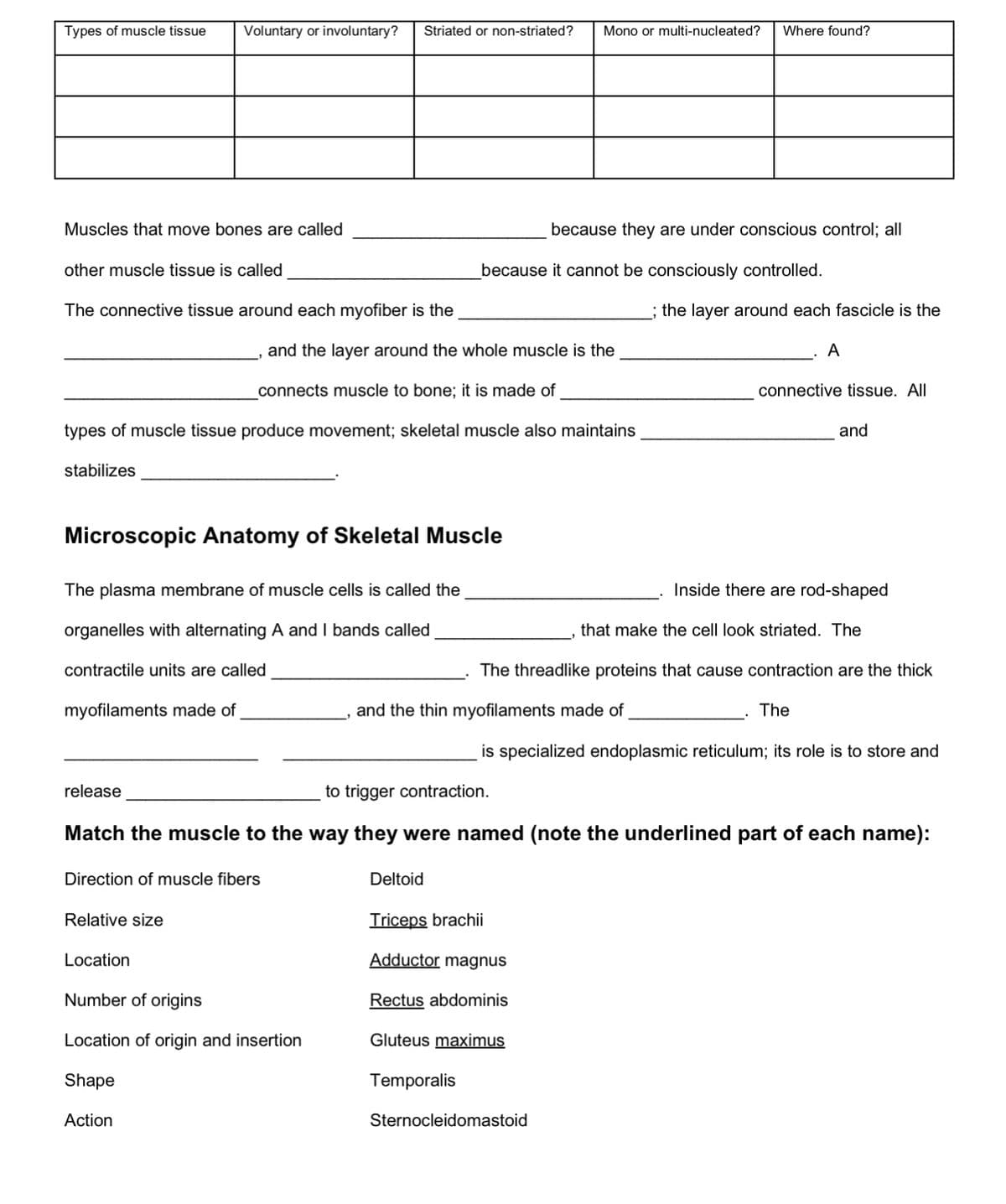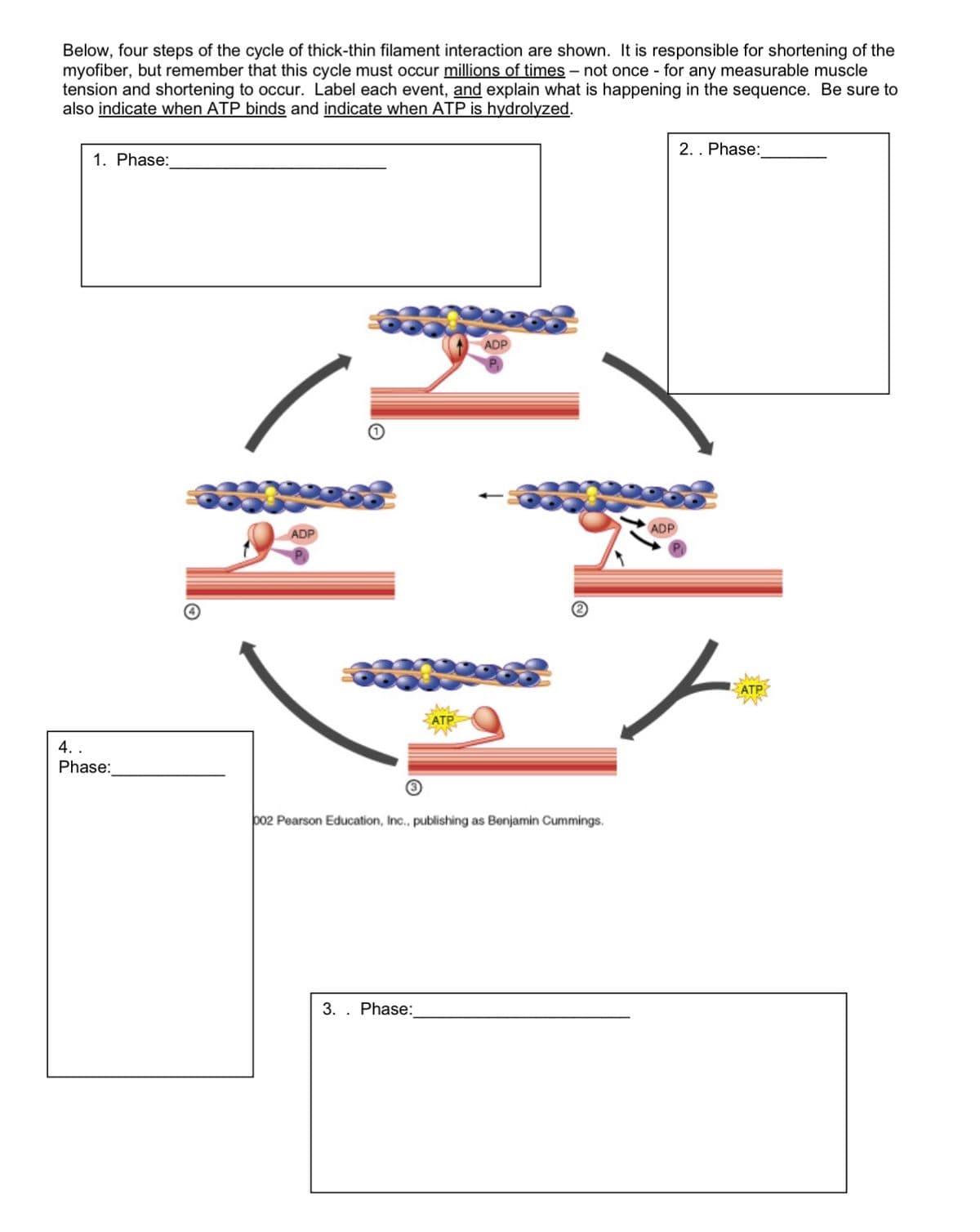Anatomy & Physiology
1st Edition
ISBN:9781938168130
Author:Kelly A. Young, James A. Wise, Peter DeSaix, Dean H. Kruse, Brandon Poe, Eddie Johnson, Jody E. Johnson, Oksana Korol, J. Gordon Betts, Mark Womble
Publisher:Kelly A. Young, James A. Wise, Peter DeSaix, Dean H. Kruse, Brandon Poe, Eddie Johnson, Jody E. Johnson, Oksana Korol, J. Gordon Betts, Mark Womble
Chapter10: Muscle Tissue
Section: Chapter Questions
Problem 8RQ: Depolarization of the sarcolemma means ________. the inside of the membrane has become Less negative...
Related questions
Question
Hi please help me answer this

Transcribed Image Text:Types of muscle tissue
Voluntary or involuntary?
Striated or non-striated?
Mono or multi-nucleated?
Where found?
Muscles that move bones are called
because they are under conscious control; all
other muscle tissue is called
because it cannot be consciously controlled.
The connective tissue around each myofiber is the
; the layer around each fascicle is the
and the layer around the whole muscle is the
A
connects muscle to bone; it is made of
connective tissue. All
types of muscle tissue produce movement; skeletal muscle also maintains
and
stabilizes
Microscopic Anatomy of Skeletal Muscle
The plasma membrane of muscle cells is called the
Inside there are rod-shaped
organelles with alternating A and I bands called
that make the cell look striated. The
contractile units are called
The threadlike proteins that cause contraction are the thick
myofilaments made of
and the thin myofilaments made of
The
is specialized endoplasmic reticulum; its role is to store and
release
to trigger contraction.
Match the muscle to the way they were named (note the underlined part of each name):
Direction of muscle fibers
Deltoid
Relative size
Triceps brachii
Location
Adductor magnus
Number of origins
Rectus abdominis
Location of origin and insertion
Gluteus maximus
Shape
Temporalis
Action
Sternocleidomastoid

Transcribed Image Text:Below, four steps of the cycle of thick-thin filament interaction are shown. It is responsible for shortening of the
myofiber, but remember that this cycle must occur millions of times – not once - for any measurable muscle
tension and shortening to occur. Label each event, and explain what is happening in the sequence. Be sure to
also indicate when ATP binds and indicate when ATP is hydrolyzed.
2. . Phase:
1. Phase:
ADP
ADP
ADP
ATP
АТР
ATP
4. .
Phase:
po2 Pearson Education, Inc., publishing as Benjamin Cummings.
3. . Phase:
Expert Solution
This question has been solved!
Explore an expertly crafted, step-by-step solution for a thorough understanding of key concepts.
This is a popular solution!
Trending now
This is a popular solution!
Step by step
Solved in 3 steps

Recommended textbooks for you

Anatomy & Physiology
Biology
ISBN:
9781938168130
Author:
Kelly A. Young, James A. Wise, Peter DeSaix, Dean H. Kruse, Brandon Poe, Eddie Johnson, Jody E. Johnson, Oksana Korol, J. Gordon Betts, Mark Womble
Publisher:
OpenStax College

Human Biology (MindTap Course List)
Biology
ISBN:
9781305112100
Author:
Cecie Starr, Beverly McMillan
Publisher:
Cengage Learning


Anatomy & Physiology
Biology
ISBN:
9781938168130
Author:
Kelly A. Young, James A. Wise, Peter DeSaix, Dean H. Kruse, Brandon Poe, Eddie Johnson, Jody E. Johnson, Oksana Korol, J. Gordon Betts, Mark Womble
Publisher:
OpenStax College

Human Biology (MindTap Course List)
Biology
ISBN:
9781305112100
Author:
Cecie Starr, Beverly McMillan
Publisher:
Cengage Learning


